Precision-engineered, high-frequency connectors have become paramount for radio frequency and microwave systems. They play a crucial role in ensuring signal integrity, stability, and performance across various applications. This blog will introduce several RF high-frequency connectors, including 1.0mm, 1.85mm, 2.4mm, 2.92mm, and 3.5mm connectors. We will explore specifications, applications, and a selection guide to help you choose the ideal RF high-frequency connectors.
What are RF High-Frequency Connectors?
RF high-frequency connectors are precision-engineered coaxial connectors used to transmit high-frequency signals. They maintain a consistent 50-ohm characteristic impedance, ensuring signals remain stable. As a result, they provide a secure and reliable connection between cables and components without degradation.
Key Features:
- Wide Frequency Range – Different connector types support applications from DC to 110 GHz.
- Excellent Electrical Performance – Maintains consistent 50-ohm impedance with low insertion loss and return loss.
- Precise Mechanical Design: They are built with extremely tight tolerances to ensure a perfect physical and electrical connection.
- Durability: Built with robust materials and secure threaded fastening mechanisms for high mechanical stability and long service life.
- Low Insertion Loss: Made with high-grade materials and precision engineering to ensure minimal insertion loss.
5 Popular RF High-Frequency Connectors
This section provides an overview of 5 popular high-frequency connectors, detailing their key features and specifications.

1.0 mm Connectors
The 1.0 mm connector, also known as the “W band” connector, is an ultra-precision miniature coaxial connector. It is engineered to meet the requirements of the most demanding high-frequency applications. It is the smallest of the coaxial connectors covered here, operating at the highest frequencies of 110 GHz. Due to its unique mechanical interface and size, it is not compatible with 1.85 mm, 2.4 mm, or 2.92 mm connectors.
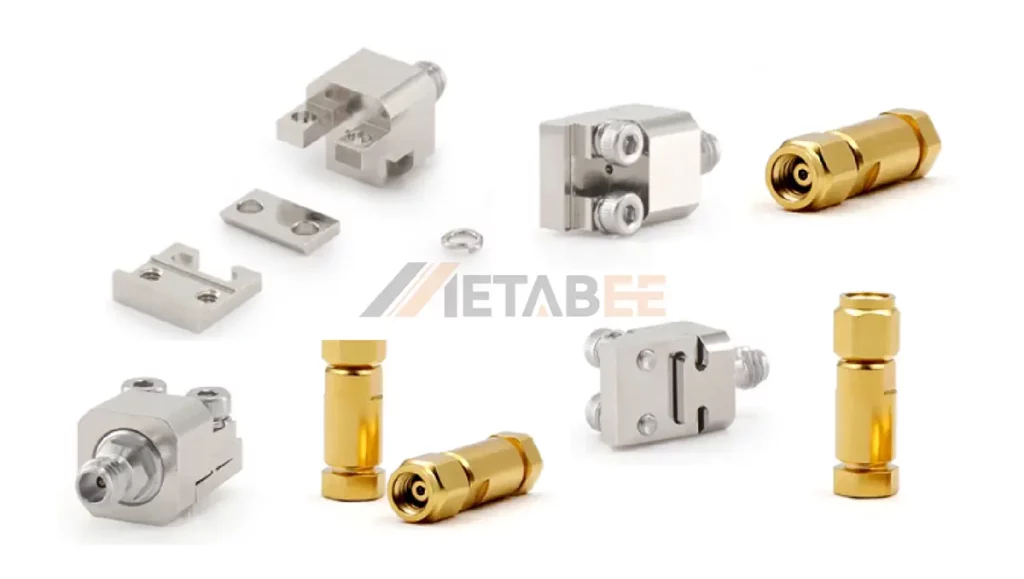
Main Specifications
| Mechanism Coupling | Threaded Coupling |
| Frequency Range | DC–110 GHz |
| Impedance | 50 Ohms |
| Termination Type | Solder |
| Interface Standard | IEC 61169-57 |
| Shell | Stainless Steel |
| Shell Plating | Passivated |
| Center Contact | Beryllium Bronze/Beryllium-Copper |
| Center Contact Plating | Gold-plated |
| Insulator | PTFE, PEI |
| Insulation Resistance | ≥ 5000 MΩ |
| Dielectric Withstanding Voltage | 750 V |
| Durability | ≥ 500 Cycles |
| Compatibility | Not compatible with 1.85mm, 2.4mm, 2.92 mm, or 3.5mm connectors |
1.85 mm Connectors
Also called the “V” connector, the 1.85mm connector is a high-frequency coaxial connector developed for millimeter-wave applications. It is used for applications up to 67 GHz. The interface uses a mostly air dielectric, which helps reduce signal loss. This connector’s robust construction makes it suitable for demanding test and measurement environments, and it is mechanically compatible with 2.4 mm connectors.
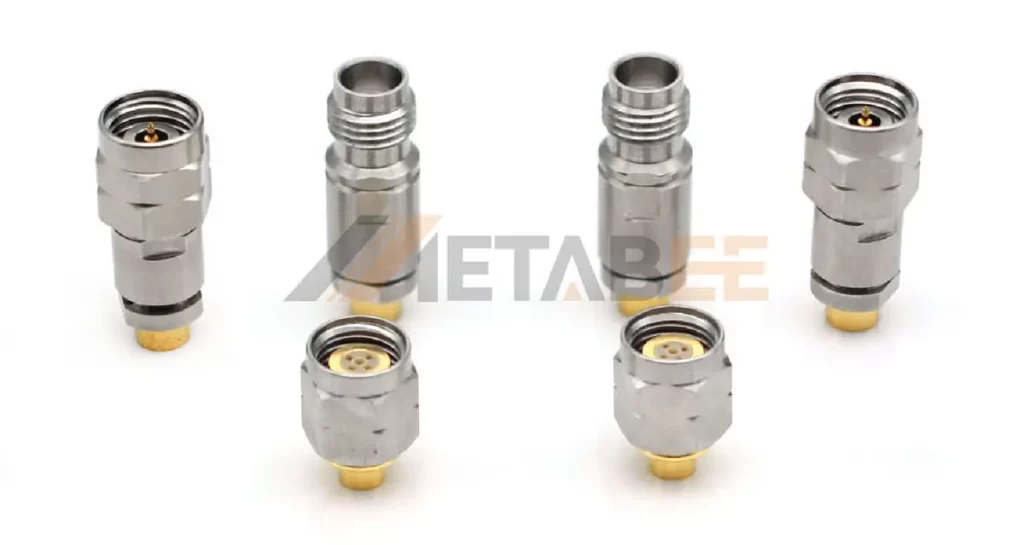
Main Specifications
| Mechanism Coupling | Threaded Coupling |
| Frequency Range | DC–67 GHz |
| Impedance | 50 Ohms |
| Termination Type | Solder, Clamp |
| Interface Standard | IEEE 287-2007 |
| Shell | Stainless Steel |
| Shell Plating | Passivation / Gold Plated |
| Center Contact | Beryllium-Copper / Beryllium Bronze |
| Center Contact Plating | Gold-plated |
| Insulator | PTFE, PEI |
| Insulation Resistance | ≥ 5000 MΩ |
| Dielectric Withstanding Voltage | 750 V |
| Durability | ≥ 500 Cycles |
| Compatibility | Compatible with 2.4 mm connectors |
2.4 mm Connectors
The 2.4 mm connector is a precision, medium-sized RF coaxial connector with a frequency range up to 50 GHz. Thanks to its robust design, this connector is known for its excellent repeatability and low signal loss. Mechanically compatible with 1.85 mm connectors. It is not compatible with SMA, 3.5 mm, or 2.92 mm connectors. It is mechanical compatibility with the 1.85 mm interface, allowing a 2.4 mm connector to mate with a 1.85mm jack. It’s a popular choice for both commercial and military applications.
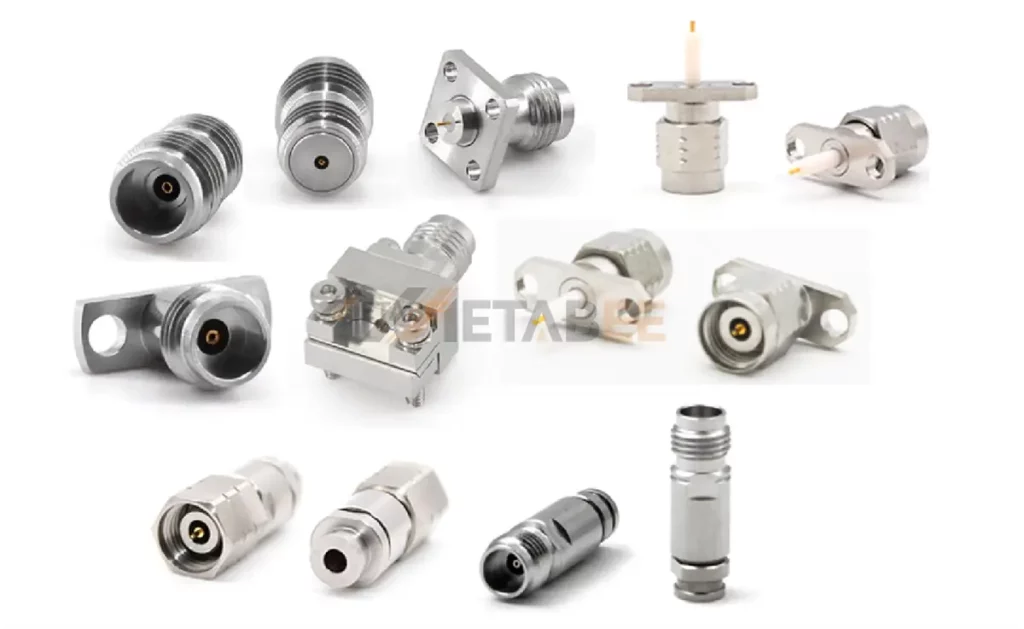
Main Specifications
| Mechanism Coupling | Threaded Coupling |
| Frequency Range | DC–50 GHz |
| Impedance | 50 Ohms |
| Termination Type | Solder, Clamp |
| Interface Standard | IEEE 287-2007 |
| Shell | Stainless Steel |
| Shell Plating | Gold Plated / Passivation |
| Center Contact | Beryllium Bronze |
| Center Contact Plating | Gold-plated |
| Insulator | PTFE, PEI |
| Insulation Resistance | ≥ 3000 MΩ |
| Dielectric Withstanding Voltage | 750 V |
| Durability | ≥ 500 Cycles |
| Compatibility | Compatible with 1.85 mm connectors |
2.92mm connectors
Often referred to as “SMA-K “connectors, the 2.92mm connector is a precision connector offering a high performance up to 40 GHz. Its design is notable for its compatibility with SMA and 3.5 mm connectors. Its smaller internal body diameter and air dielectric allow it to support higher frequencies than standard SMA connectors.
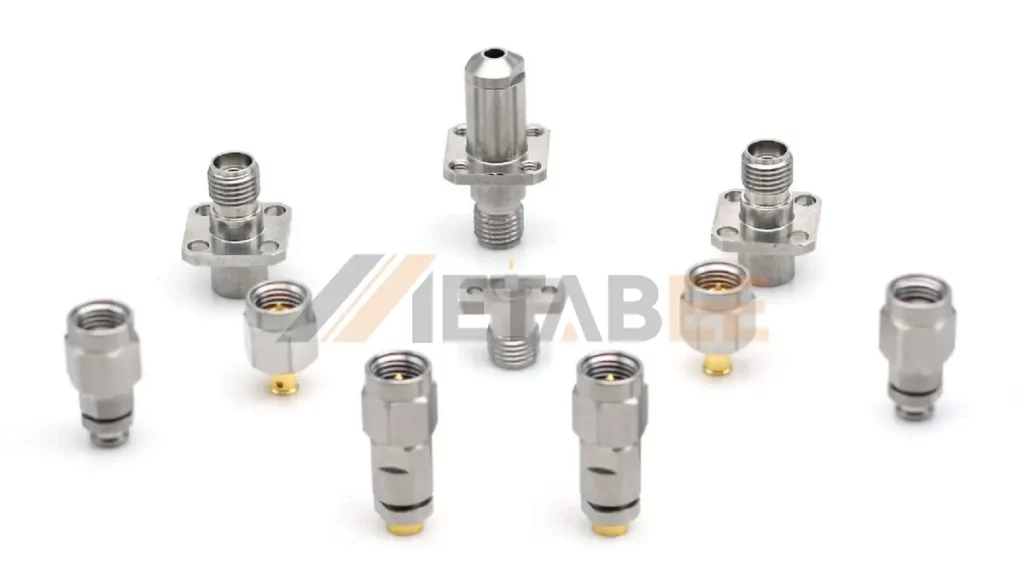
Main Specifications
| Mechanism Coupling | Threaded Coupling |
| Frequency Range | DC–26.5 GHz |
| Impedance | 50 Ohms |
| Termination Type | Solder |
| Interface Standard | IEC 61169-35 |
| Shell | Brass / Stainless Steel |
| Shell Plating | Passivation / Gold-plated |
| Center Contact | Beryllium-Copper / Brass |
| Center Contact Plating | Gold-plated |
| Insulator | PEI, Teflon |
| Insulation Resistance | ≥ 1000 MΩ |
| Dielectric Withstanding Voltage | 750 V |
| Durability | ≥ 500 Cycles |
| Compatibility | Compatible with SMA and 1.85 mm connectors |
3.5mm RF Connectors
Developed in the mid-1970s, the 3.5mm connector is a rugged and reliable coaxial connector that provides mode-free operation up to 26.5 GHz. It has an outer conductor diameter of 3.5 mm and an air-filled interface. Crucially, it is interchangeable with both SMA and 2.92 mm connectors, providing flexibility and convenience.
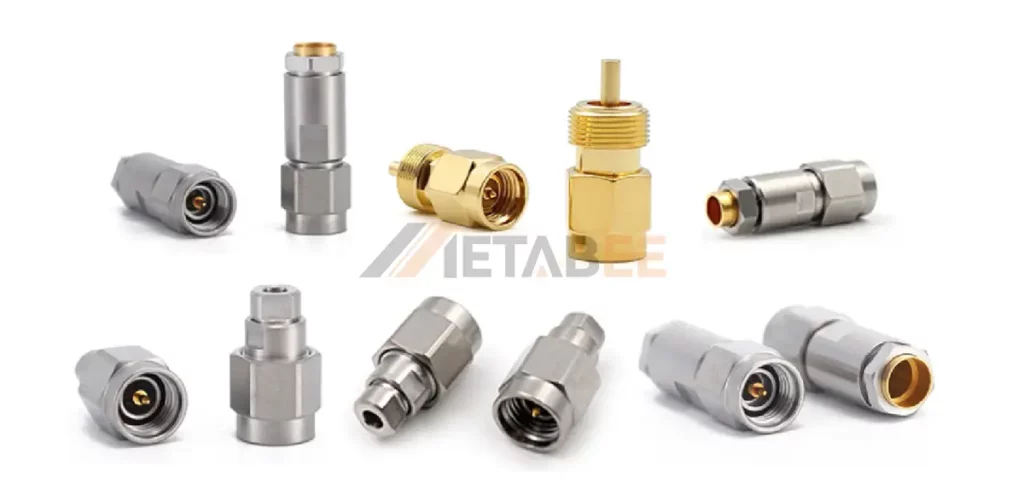
Main Specifications
| Mechanism Coupling | Threaded Coupling |
| Frequency Range | DC–26.5 GHz |
| Impedance | 50 Ohms |
| Termination Type | Solder |
| Interface Standard | IEC 61169-35 |
| Shell | Brass / Stainless Steel |
| Shell Plating | Passivation / Gold-plated |
| Center Contact | Beryllium-Copper / Brass |
| Center Contact Plating | Gold-plated |
| Insulator | PEI, Teflon |
| Insulation Resistance | ≥ 1000 MΩ |
| Dielectric Withstanding Voltage | 750 V |
| Durability | ≥ 500 Cycles |
| Compatibility | Compatible with SMA and 1.85 mm connectors |
Compatibility Comparison of SMA and 1.85mm, 2.4mm, 2.92mm, 3.5mm Connectors
Although 1.85mm, 2.4mm, 2.92mm, 3.5mm, and SMA connectors differ in design, they remain compatible and can be used together.
Compatibility of these connectors is shown in the image below.

Common Applications
RF high-frequency connectors are used in a wide range of applications, including:
- Test and Measurement: Used in high-performance test equipment like Vector Network Analyzers (VNAs) and oscilloscopes for accurate characterization of high-frequency components and circuits.
- Aerospace and Defense: Critical for radar systems, satellite communications, and avionics, where performance and reliability in harsh environments are non-negotiable.
- Telecommunications: Integral to 5G, 6G, and other millimeter-wave communication systems, ensuring low-loss signal transmission in base stations and network infrastructure.
- High-Speed Data: Found in high-speed digital systems and optical networking, where they connect modules and components that operate at extremely high data rates.
- Research and Development: Used in laboratories for cutting-edge research in physics, quantum computing, and emerging technologies that rely on high-frequency signals.
2.92mm vs. SMA vs 2.4mm
Choosing the right connector often comes down to understanding the trade-offs between different series. Here’s a comparison between these connectors.
2.92 mm vs. SMA Connectors
The key difference lies in the frequency range. SMA connectors are typically rated up to 18 GHz, while 2.92mm connectors are designed for a much higher frequency range, up to 40 GHz.
Differences between SMA and 2.9 mm RF connectors:
| Feature | 2.92mm | SMA |
|---|---|---|
| Frequency Range | DC-40 Ghz | DC-18 Ghz |
| Center Contact Size | Smaller | Larger |
| Dielectric | Air dielectric | PTFE (Teflon) dielectric |
| Insertion loss | Lower insertion loss | High insertion loss |
| Cost | More expensive | More affordable |
SMA vs. 2.4 mm Connectors
This comparison is about both performance and mechanical robustness. SMA connectors are economical and widely available, but are not designed for frequencies above 18 GHz. On the other hand, the 2.4 mm connector series is specifically engineered to handle frequencies up to 50 GHz. Its thick outer wall and more robust design make it significantly more durable than the SMA, ideal for applications requiring frequent connections and disconnections.
Comparison of SMA and 2.4 mm RF connectors:
| Feature | SMA | 2.4 mm |
|---|---|---|
| Frequency Range | DC-18 Ghz | DC-50 Ghz |
| Dielectric | PTFE (Teflon) dielectric | Air-dielectric |
| Insertion loss | High insertion loss | Lower insertion loss |
| Compatibility | Compatible with 2.4mm, 3.5mm | Compatible with 1.85mm |
| Size | Larger | Smaller |
| Cost | More affordable | More expensive |
How to choose the right connector from these connectors?
Selecting the right connector involves balancing several key factors:
- Frequency Range: Make sure the connector can support the required frequency.
- Impedance Matching: Ensure that the connector impedance matches the system’s transmission line to avoid signal reflection.
- Durability: Consider the mating cycles and environmental conditions of the connector will be exposed.
- Size and Form Factor: Depending on the application, you may need compact connectors like 1.0mm or larger connectors like 3.5mm.
- Cost and Availability: Higher frequency and more robust connectors are more expensive. Balance your performance needs against your budget constraints.
Why Choose Metabee’s High Frequency Connectors?
Metabee offers a wide range of high-quality RF connectors designed to meet the rigorous demands of modern high-frequency applications. Our products stand out for several reasons:
- Wide Product Range: From 1.0 mm to 3.5 mm, we provide a comprehensive selection of connectors and adapters, giving you the flexibility to find the perfect component for your specific needs.
- Competitive Pricing: As the direct manufacturer, we eliminate the middlemen to offer high-quality products at competitive prices, without compromising performance.
- Expert Technical Support: Our team provides expert guidance to help you select the perfect connector for your specific application, ensuring optimal system performance.
- Customer Support: With a responsive sales team, we offer real-time support, prompt quotes, and dependable after-sales service.
- Customization: We can offers tailored solutions for unique project requirements.
Conclusion
RF high-frequency connectors are a cornerstone of modern electronics, enabling a wide range of applications. The choice between 1.0mm, 1.85mm, 2.4mm, 2.92mm, and 3.5mm connectors depends heavily on the specific application’s frequency requirements, power handling, and budget. By understanding the unique characteristics of these connector types, we can make an informed decision that will ensure the high performance and reliability of the system. With advanced engineering and strict quality standards, Metabee’s high-frequency connectors deliver consistent performance and long-term reliability across diverse industries.
Related Products
- 2.92mm Connectors
- 1.0mm Connectors
- 1.85mm Connectors
- 2.4mm Connectors
- 3.5mm Connectors
- 2.92mm Adapters
- 2.4mm Adapters
- 1.85mm Adapters
- RF Test Cables
Frequently Asked Questions (FAQ)
Q1: Can I mate an SMA connector with a 2.92mm connector?
A: Yes. You can mate a 2.92mm plug (male) with an SMA jack (female).
Q2: What is the main difference between a 2.92 mm and a 3.5 mm connector?
A: The main difference is the maximum operating frequency. A 3.5 mm connector is up to 34 GHz, while a 2.92 mm connector extends this to 40 GHz. They are mechanically and electrically compatible, allowing for interchangeability.
Q3: Can I connect a 2.4 mm connector to an SMA connector?
A: No. 2.4 mm and SMA connectors are not interchangeable. You must use an adapter to connect these two types. Attempting to force a connection will likely damage both connectors.
Q4: Are 2.92mm connectors compatible with SMA connectors?
A: Yes. 2.92mm connectors are mechanically compatible with SMA and 3.5mm connectors.
Q5: Can Metabee’s connectors be customized for my specific application?
A: Yes. Metabee offers customization options to meet specific project needs, including special sizes, terminations, and impedance values.